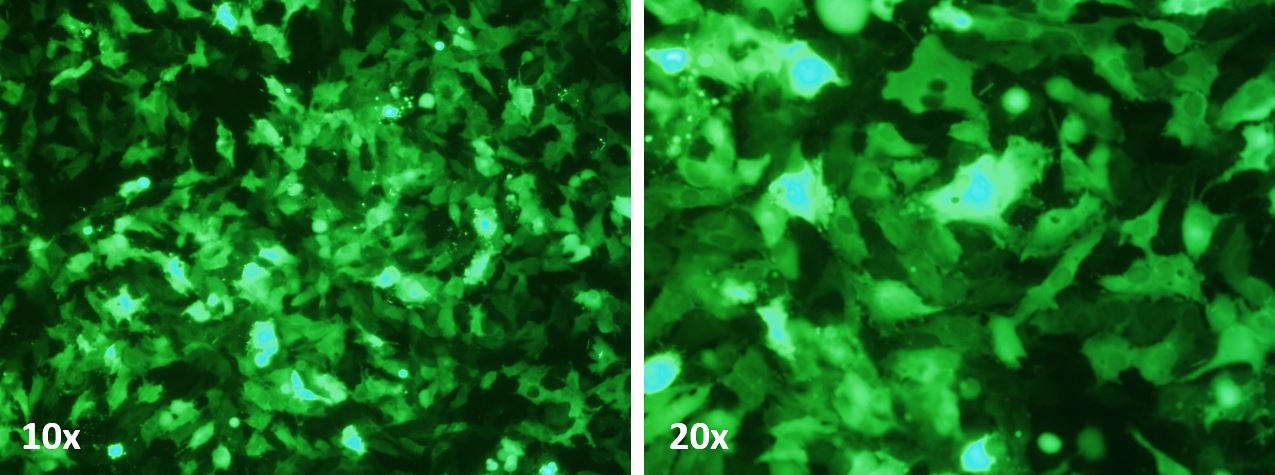Description
Cell to transfect:
Designations: MDA-MB-468
Cell Synonyms: : HTB-132, human breast carcinoma cell
Depositors: R Cailleau
Growth Properties: adherent
Organism: Homo sapiens
Morphology: epithelial
Source: mammary gland; breast
Disease: adenocarcinoma
Isolation date: 1977
Applications: transfection host
Receptors: epidermal growth factor (EGF), transforming growth factor alpha (TGF alpha)
Tumorigenic: Yes
Antigen Expression: Blood Type AB; HLA Aw23, Aw30, B27, Bw35, Cw2, Cw4 (patient)
Age: 51 years
Gender: female
Ethnicity: Black
Comments: The MDA-MB-468 cell line was isolated in 1977 by R. Cailleau, et al., from a pleural effusion of a 51-year-old Black female patient with metastatic adenocarcinoma of the breast. Although the tissue donor was heterozygous for the G6PD alleles, the cell line consistently showed only the G6PD A phenotype. There is a G -> A mutation in codon 273 of the p53 gene resulting in an Arg -> His substitution. EGF receptor is present at 1 X 10(6) per cell.
Features of the Transfection Reagent:
- Broad spectrum for the transfection of large plasmid, mRNA, siRNA, and/or other type of nucleic acids, which is best for co-transfection of different type and/or size of nucleic acids.
- Specifically optimized to deliver nucleic acids into MDA-MB-468 cells
- Extremely gentle to cells
- 0.5 ml is able to transfect about 1000 wells of 24-well plate
- Deliver single or multiple plasmids
- Efficient for plasmid DNA/siRNA co-transfection
- Compatible with serum
- Compatible with transfection in any plate formats
- Reproducible: due to highly controlled chemical synthesis of each of the ingredients, the reagent forms uniformly sized complex particles with nucleic acids. With optimized protocol, our reagent will ensure the reproducible highest transfection results.
- Economical: High efficiency means less amount of nucleic acid & reagent is needed
Data
 FIG. 1. High throughput test of transfection efficiency (determined as RLU/mg) on MDA-MB-453 cells after transfection of luciferase reporter gene by using our 172 proprietary transfection formulas and several most popular commercial transfection reagents. The yellow box showed the results of 4 commercial transfection reagents. The red lines marked our candidate formulas with the highest transfection efficiency for MDA-MB-453 cells. This test result was confirmed with repeat experiments. The candidate formulas were also tested on MDA-MB-468 cells by transfecting GFP expression plasmid, and got the same high transfection efficiency after flow cytometry analysis. The one that showed the optimal balance of potent & low cytotoxicity (percentage of 7AAD positive cells) among those candidate formulas was later named as MDA-MB-468 Cell Avalanche® Transfection Reagent.
FIG. 1. High throughput test of transfection efficiency (determined as RLU/mg) on MDA-MB-453 cells after transfection of luciferase reporter gene by using our 172 proprietary transfection formulas and several most popular commercial transfection reagents. The yellow box showed the results of 4 commercial transfection reagents. The red lines marked our candidate formulas with the highest transfection efficiency for MDA-MB-453 cells. This test result was confirmed with repeat experiments. The candidate formulas were also tested on MDA-MB-468 cells by transfecting GFP expression plasmid, and got the same high transfection efficiency after flow cytometry analysis. The one that showed the optimal balance of potent & low cytotoxicity (percentage of 7AAD positive cells) among those candidate formulas was later named as MDA-MB-468 Cell Avalanche® Transfection Reagent.
 FIG. 2. MDA-MB-468 cells were transfected with GFP vector (pEGFP-N3) by using MDA-MB-468 Cell Avalanche® Transfection Reagent. The cells were visualized by Nikon Eclipse Fluorescence microscope 48 hours post transfection.
FIG. 2. MDA-MB-468 cells were transfected with GFP vector (pEGFP-N3) by using MDA-MB-468 Cell Avalanche® Transfection Reagent. The cells were visualized by Nikon Eclipse Fluorescence microscope 48 hours post transfection.
For Other Cells
MDA-MB-468 Cell Avalanche® Transfection Reagent (human breast carcinoma cell) can also be used on the following cells with high transfection efficiencies.
4T1 Cell
ZR-75-1 Cell
BT-20 Cell
MDA-MB-453 Cell
HCC1937 Cell
SK-BR-3 Cell
MDA-MB-231 Cell
293 Cell
293T/17 Cell
Recommended protocols for these cells will be provided with the reagent. The protocols usually provide satisfactory transfection efficiency with invisible cytotoxicity. However, optimization may be needed for certain type of cells. Optimizations may include: the amount of DNA and this transfection reagent; cell density; transfection reagent/DNA ratio, or incubation time for the mixture of transfection reagent/DNA etc. For best transfection result, we recommend using the respective cell type/cell line specific Avalanche transfection reagents. Those reagents have been optimized on both recipes and protocols, and have been proved to have the best transfection results for the respective cell lines or primary cells. You can easily find the respective Avalanche transfection reagents specific for your cells by using the filters of our product list.
Additional Information
| Weight | 0.5 lbs |
|---|---|
| Adherence Phenotype |
Adherent |
| Cell Type |
Epithelial Cell |
| Disease |
Cancer |
| Names starting from |
M |
| Primary/Cell Line |
Cell Line |
| Product Sizes |
0.5 ml, 1.5 ml |
| Species |
Human |
| Tissue Sources |
Breast/Mammary |
| Subcategories |
Cell Type/Cell Line Specific |
Documents
Citations or Feedback


